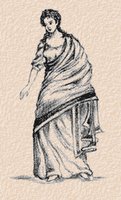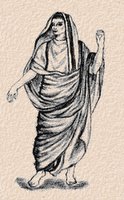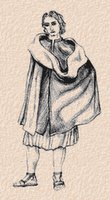Ancient Roman fashion

 Roman ingenuity of solving problems of all sorts was not only to apply itself to engineering and architecture, but also to the mundane matter of clothing.
Roman ingenuity of solving problems of all sorts was not only to apply itself to engineering and architecture, but also to the mundane matter of clothing.First and foremost clothes needed to be simple. As for possible materials there was only really one. Wool, although to some extent linen was also available.
The needles of the day were coarse and unwieldy. Hence any stitching or sewing produced less than elegant garments. This of course also ruled out button holes, and meant that any kind of clothing was held together wither with knows or safety pins.
As undergarments Romans would wear a simply loin cloth knotted on each side. This garment appeared to have several names. The most probable explanation for this is that they varied in shape.
They were the subligar, subligaculum, campestre, cinctus.
Women would also wear a simple brassière in the form of a band, tightly tied around her body.
If in the early days the toga was worn directly on the naked body, then later a simple tunic was added, tied at the waist with a belt.
There was some old families with ancient ancestry insisted on continuing the tradition of dressing without a tunic, but their fellow Romans understood them to be old fashioned r
 elics of times by.
elics of times by.Roman men generally wore two garments, the tunica and the toga. The tunica was a short woolen under garment with short sleeves. By contrast, to wear a long tunic with long sleeves was considered effeminate and was generally avoided by society as a whole. It was originally worn mainly by the working class plebes, freedmen and slaves, though its function as an undergarment for any class of people is attested. As the toga was specifically meant as a public display garment, the tunica was also worn by any people within the comforts of their own homes. The tunic worn by patrician men was made from white wool or expensive linen, while the poor would
 wear whatever fabric was readily available. Similar to the toga, distinct tunics were worn to signify one's title. Magistrates wore the tunic augusticlavia, and senators wore a tunic with broad strip called the tunica laticlavia. In addition, a belt would be worn around the waist of the tunica to hold the waist of the garment snug, giving the impression of a two piece garment.
wear whatever fabric was readily available. Similar to the toga, distinct tunics were worn to signify one's title. Magistrates wore the tunic augusticlavia, and senators wore a tunic with broad strip called the tunica laticlavia. In addition, a belt would be worn around the waist of the tunica to hold the waist of the garment snug, giving the impression of a two piece garment.Thanks to:
Roman-empire.net
unrv.com

0 Comments:
Post a Comment
<< Home